沙漠之舟1
沙漠之舟精品PPT课件

骆驼的外形有什么特点呢?
填一填:
沙漠环境 骆驼的生理特点
作用
填一填:
沙漠环境
宽广无边
骆驼的生理特点
作用
身体很高,脖子很长 能看到很远的地方
填一填:
沙漠环境
宽广无边 缺水
骆驼的生理特点
身体很高,脖子很长 嗅觉灵敏
作用
能看到很远的地方 找水源
填一填:
沙漠环境
宽广无边 缺水 风沙大
骆驼的生理特点
身体很高,脖子很长 嗅觉灵敏
鼻孔能紧闭 腿ቤተ መጻሕፍቲ ባይዱ有胼胝
脚掌又宽又厚,脚趾 分开
作用
能看到很远的地方 找水源 防风沙
不会烫伤 不会陷进沙子里
沙漠环境
宽广无边 缺水
风沙大 沙子滚烫 沙子松软 缺少水草
骆驼的生理特点
身体很高,脖子很长 嗅觉灵敏
鼻孔能紧闭 腿上有胼胝 脚掌又宽又厚,脚趾分开 驼峰把养料变成脂肪
学习提示
自由读课文,读通读顺课文,不理解 的地方多读几遍。想一想文章主要讲 了哪几部分内容?
学习提示:
1、默读课文第一自然段,用“ ”,画 出骆驼的生理特点,用“﹏﹏ ”画出该生 理特点的作用。
2、小组讨论:骆驼身体各部分有什么特点? 这些特点跟骆驼在沙漠中的生活有什么关 系?
“舟”是什么意思? 船在哪里航行? 沙漠里有船吗? 沙漠之舟指的是什么?
看了课题,你有什么问题吗?
沙 漠 之 舟
读一读:
• 骆驼 嗅觉 胼胝 烫伤 • 脚趾 脂肪 缺乏 积蓄 • 维持 跪下
读读词语,想想这组词语都是描写什么景物的 ?
滚热的沙子 松软的沙子 陷进沙子里 宽广无边的沙漠 刮起卷着沙子的旋风 大风卷着沙粒飞滚 移来整座沙丘
《沙漠之舟》教学设计_教案教学设计_1
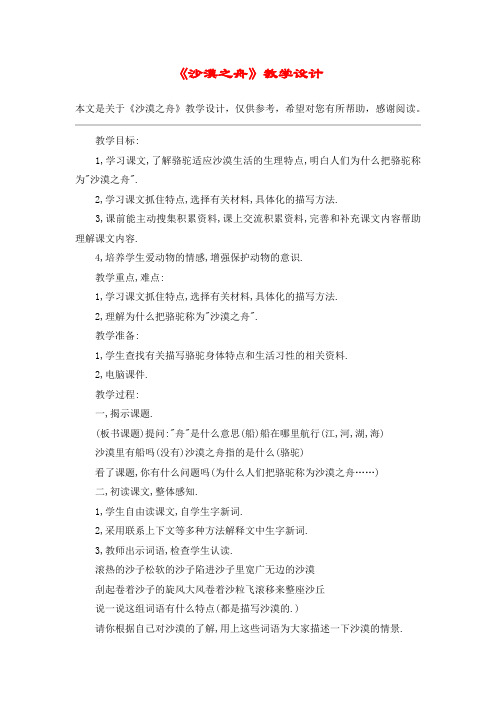
《沙漠之舟》教学设计本文是关于《沙漠之舟》教学设计,仅供参考,希望对您有所帮助,感谢阅读。
教学目标:1,学习课文,了解骆驼适应沙漠生活的生理特点,明白人们为什么把骆驼称为"沙漠之舟".2,学习课文抓住特点,选择有关材料,具体化的描写方法.3,课前能主动搜集积累资料,课上交流积累资料,完善和补充课文内容帮助理解课文内容.4,培养学生爱动物的情感,增强保护动物的意识.教学重点,难点:1,学习课文抓住特点,选择有关材料,具体化的描写方法.2,理解为什么把骆驼称为"沙漠之舟".教学准备:1,学生查找有关描写骆驼身体特点和生活习性的相关资料.2,电脑课件.教学过程:一,揭示课题.(板书课题)提问:"舟"是什么意思(船)船在哪里航行(江,河,湖,海)沙漠里有船吗(没有)沙漠之舟指的是什么(骆驼)看了课题,你有什么问题吗(为什么人们把骆驼称为沙漠之舟……)二,初读课文,整体感知.1,学生自由读课文,自学生字新词.2,采用联系上下文等多种方法解释文中生字新词.3,教师出示词语,检查学生认读.滚热的沙子松软的沙子陷进沙子里宽广无边的沙漠刮起卷着沙子的旋风大风卷着沙粒飞滚移来整座沙丘说一说这组词语有什么特点(都是描写沙漠的.)请你根据自己对沙漠的了解,用上这些词语为大家描述一下沙漠的情景.出示课件,感受沙漠,学生可以边看边说.4,引导学生选择自己喜欢的段落再次朗读,读到自己满意为止.三,深入学习,理解课文内容.1,骆驼为什么能在沙漠里生活(1)学生自学.①分组学习,在书中找出相关词句,画出来.②边读边讨论:骆驼身体各部分有什么特点这些特点跟骆驼在沙漠里的生活有什么关系③填表特殊生理构造适合沙漠生活成为交通工具身高,脖子长望到很远的地方嗅觉灵敏找水源,避旋风鼻子能张能闭沙尘难以侵入沙漠里重要的交通工具.腿上有胼胝不会烫伤脚掌宽厚,脚趾分开不会陷入沙子里背上有驼峰储存养料(2)检查自学情况.指名学生展示自己所填的表格.用"由于……因此","因为……所以",或"是因为"等词语将句子连起来.例如:由于骆驼腿上有胼胝,因此不会被滚热的沙子烫伤.(3)学生补充介绍查找到的有关骆驼的资料.(4)指导学生朗读第一自然段.(5)讨论:骆驼身上的这些特点是按什么顺序介绍的(从上到下,从头到脚的顺序)(6)小结:这一段除了第一句外,其他的句子有一个共同的特点:前半句介绍特点,后半句说明作用.2,人们为什么把骆驼称为"沙漠之舟"(1)小组进行合作学习.先读读课文2,3,4自然段,然后讨论,找出答案.看哪个小组又快又对.交流前提示:将骆驼的特殊本领和骆驼的特点相结合进行交流.(2)学生交流.(骆驼身体高,脖子长,能望到很远的地方,能够为旅行的人带路;骆驼嗅觉灵敏,人们可以用它来预报气象;骆驼有宽厚的脚掌,腿上有胼胝,背上有驼峰,人们可以利用它做沙漠里的交通工具,所以人们把骆驼称为"沙漠之舟".)(3)思考:沙漠和大海有什么相似的地方(大海和沙漠都是"宽广无边"茫茫一片;大海波涛起伏,沙漠里"到处是高高低低的沙丘";海上的风浪很大,沙漠里的大风"很可怕",经常"卷着沙粒飞滚".)骆驼和船相似的地方(船是海上重要的交通工具,骆驼是沙漠里的重要交通工具.)(4)指导朗读第二至四自然段.四,总结全文.这篇课文是一篇描写动物的说明文,以"沙漠之舟"为题,着重介绍了骆驼的生理特点和特殊的本领及被称为"沙漠之舟"的原因.作者抓住骆驼的特点,按顺序进行介绍,写得生动具体,有条有理.今后我们在写作时也可以尝试这种方法.五,课后拓展.说一说你喜欢的一种小动物的生理特点和生活习性以及有什么特殊的本领.六,布置作业.把上面说的内容整理成一篇写动物的说明文.。
沙漠之舟课文原文

沙漠之舟课文原文沙漠之舟是我们需啊哟学习的课文,各位,大家一起看看下面的原文,欢迎各位同学阅读。
沙漠之舟课文原文骆驼生活在沙漠里。
它身体很高,脖子很长,能够7望到很远的地方。
沙漠里有水的地方很少,骆驼的嗅觉很灵敏,能帮助人们找到水源。
每逢沙漠里刮起卷着沙子的旋风,它的鼻孔主紧紧地闭起来。
骆驼的腿上有一大片胼胝,它就是趴在被太阳晒得滚热的沙子上,也不会烫伤。
骆骆的脚掌又宽又厚,走路的时候,两个脚趾分开,不会陷到松软的沙子一部分养料变成脂肪储藏在驼峰里。
等到缺乏食物的时候,它就是用自己积蓄的营养来维持生命。
洮漠宽广无边,到处是高高低低的人很认路。
骆驼却能在沙漠里给我们带路。
沙漠里的大风是很可怕的,大风卷着沙粒飞滚,有时会移来整座沙丘,把人和牲口全埋在底下。
骆驼熟悉沙漠里的气候,快要刮风了,它就跪下,旅行的人可以预先做好准备。
骆驼走得很慢,可是能驮很多东西。
它是沙漠里重要的交通工具,人们把它看做渡过沙漠之海的航船,称它为“沙漠之舟”。
扩展阅读沙漠之舟教案目标:1、能正确、流利、有感情地朗读课文,了解骆驼适应沙漠生活的生理特点,明白人们为什么把骆驼称为“沙漠之舟”。
2、学习课文抓住特点、选择有关材料、具体化的描写方法。
3、能将课后资料进行修改,插入课文相关段落,完善和补充课文内容。
4、培养学生爱动物的情感,增强保护动物的意识。
说学情和重难点:根据教材编排的特点,我确定本文教学的重点为:学习课文抓住特点、选择有关材料、具体化的描写方法。
难点为:理解为什么把骆驼称为“沙漠之舟”。
说教法:本课教学采用“问题探究”的教法,引导学生带着问题,自己去读懂课文,获得知识。
凡是学生能读懂的,都让学生自己去读。
每一次读,教师都提出明确的要求,引导学生主动探索、理解。
着重对学生自主合作能力的培养。
同时,引导学生通过查阅资料,充分利用课外资源补充课内有限的内容,加深对课文内容的理解。
说教学设计:本文教学分两课时完成。
第一课时的内容主要是围绕问题:为什么把骆驼称作“沙漠之舟”?引导学生自主合作学习课文;第二课时的内容主要是指导学生书写本课的生字及合理修改选择资料,补充课文内容;引导学生运用课文中所学到的方法,观察自己喜欢的动物,进行练笔。
沙漠之舟阅读原文

沙漠之舟阅读原文沙漠之舟阅读原文沙漠之舟就是骆驼,因为骆驼和其他动物不一样,特别耐饥耐渴,人们能骑着骆驼横穿沙漠,所以有“沙漠之舟”的美称。
下面小编给大家带来《沙漠之舟》阅读原文,欢迎大家阅读。
《沙漠之舟》阅读原文骆驼生活在沙漠里。
它身体很高,脖子很长,能够7望到很远的地方。
沙漠里有水的地方很少,骆驼的嗅觉很灵敏,能帮助人们找到水源。
每逢沙漠里刮起卷着沙子的旋风,它的鼻孔主紧紧地闭起来。
骆驼的腿上有一大片胼胝,它就是趴在被太阳晒得滚热的沙子上,也不会烫伤。
骆骆的脚掌又宽又厚,走路的时候,两个脚趾分开,不会陷到松软的沙子一部分养料变成脂肪储藏在驼峰里。
等到缺乏食物的时候,它就是用自己积蓄的营养来维持生命。
洮漠宽广无边,到处是高高低低的人很认路。
骆驼却能在沙漠里给我们带路。
沙漠里的大风是很可怕的,大风卷着沙粒飞滚,有时会移来整座沙丘,把人和牲口全埋在底下。
骆驼熟悉沙漠里的气候,快要刮风了,它就跪下,旅行的人可以预先做好准备。
骆驼走得很慢,可是能驮很多东西。
它是沙漠里重要的交通工具,人们把它看做渡过沙漠之海的航船,称它为“沙漠之舟”。
《沙漠之舟》教案本课教材分析:《沙漠之舟》是一篇描写动物的说明文,课文以“沙漠之舟”为题,着重介绍了骆驼适应沙漠生活以及它如何帮助人们穿越沙漠,被称为“沙漠之舟”的原因。
全文共有四个自然段,按照内容的不同可以分为两个层次。
第一层次(第一自然段):讲骆驼适应沙漠生活的原因,在介绍骆驼适应环境的独特身体特点的过程中,也展示出沙漠广阔无垠、干旱炎热、缺少水草、风大沙烫、沙地松软的特点。
第二层次(第二至四自然段):介绍骆驼被称为沙漠之舟的原因。
三个自然段从骆驼能给人们带路、指引方向,预报大风和能驮东西,是沙漠里重要的交通工具这三方面介绍骆驼在沙漠中的重要作用。
也正因为这三方面人们才会把它看作渡过沙漠之海的航船,称它为“沙漠之舟”。
课文的两部分内容有着密切的联系,正因为骆驼适应沙漠的恶劣环境,能在沙漠环境中畅通无阻,所以才能给人引路,预报大风,驮运物品,才能当之无愧地被称为“沙漠之舟”。
《沙漠之舟》

:46:06| 分类:教案设计|举报|字号订阅本课教材分析:《沙漠之舟》是一篇描写动物的说明文,课文以“沙漠之舟”为题,着重介绍了骆驼适应沙漠生活以及它如何帮助人们穿越沙漠,被称为“沙漠之舟”的原因。
全文共有四个自然段,按照内容的不同可以分为两个层次。
第一层次(第一自然段):讲骆驼适应沙漠生活的原因,在介绍骆驼适应环境的独特身体特点的过程中,也展示出沙漠广阔无垠、干旱炎热、缺少水草、风大沙烫、沙地松软的特点。
第二层次(第二至四自然段):介绍骆驼被称为沙漠之舟的原因。
三个自然段从骆驼能给人们带路、指引方向,预报大风和能驮东西,是沙漠里重要的交通工具这三方面介绍骆驼在沙漠中的重要作用。
也正因为这三方面人们才会把它看作渡过沙漠之海的航船,称它为“沙漠之舟”。
课文的两部分内容有着密切的联系,正因为骆驼适应沙漠的恶劣环境,能在沙漠环境中畅通无阻,所以才能给人引路,预报大风,驮运物品,才能当之无愧地被称为“沙漠之舟”。
学校及学生状况分析:我班学生在课堂上的思维很活跃,理解能力和自读自悟方面的学习能力较强,而且大部分学生喜欢阅读课外书籍,常常会在课堂上结合自己的课外知识来理解课文内容,谈自己的认识。
所以课前要求学生通过书本、影视、网络、问家长等手段,查找有关骆驼及沙漠的资料,积累一定的感性知识。
这样,在课堂上就容易与课文产生共鸣,较快地进入情境。
学生已经能够在小组长的带领下,通过合作进行探究学习,所以本课在突破重难点时,设计了小组合作学习,进一步培养学生自主合作的能力。
教学目标:1、学习课文,了解骆驼适应沙漠生活的生理特点,明白人们为什么把骆驼称为“沙漠之舟”。
2、学习课文抓住特点、选择有关材料、具体化的描写方法。
3、能将课后资料进行修改,插入课文相关段落,完善和补充课文内容。
4、能正确、流利、有感情地朗读课文5、培养学生爱动物的情感,增强保护动物的意识。
教学重点、难点:1、学习课文抓住特点、选择有关材料、具体化的描写方法。
沙漠之舟ppt课件

沙漠之舟的应用范围广泛,包括但不限 于以下几个方面
交通运输:在偏远地区,沙漠之舟可以 作为重要的交通工具,为人们提供快速 的移动方式。
应用和价值的案例分析
交通运输案例
在偏远地区,如非洲和阿拉伯半 岛,沙漠之舟被广泛用于运输货 物和人员,为当地经济发展提供
了重要的支持。
探险旅游案例
在一些探险旅游线路中,如撒哈 拉沙漠、阿塔卡马沙漠等,沙漠 之舟成为探险者的重要交通工具 ,为他们在沙漠中提供了方便和
舒适的住所。
军事用途案例
在一些战争和冲突地区,如伊拉 克、阿富汗等,沙漠之舟被作为 移动的战斗平台,为部队提供火 力支援和移动掩护,提高了作战
效率。
应用和价值的挑战与机遇
要点一
挑战
沙漠之舟的应用也存在一些挑战,如维护成本高、燃料消 耗大、行驶速度较慢等问题,这些问题限制了沙漠之舟的 应用范围和价值。
要点二
机遇
随着科技的不断进步和应用,未来沙漠之舟的应用前景将 更加广阔。例如,可以使用更先进的车辆设计和制造材料 ,提高沙漠之舟的性能和使用寿命;同时也可以开发更高 效的能源利用技术,降低沙漠之舟的燃料消耗和维护成本 。此外,随着探险旅游业的不断发展,沙漠之舟将成为更 多人的选择,为人们提供更加丰富和刺激的旅游体验。
沙漠之舟ppt课件
contents
目录
• 引言 • 沙漠之舟的构造和设计 • 沙漠之舟的历史和发展 • 沙漠之舟的应用和价值 • 沙漠之舟的未来展望与思考
01
CATALOGUE
引言
沙漠之舟的背景介绍
沙漠之舟的起源
沙漠之舟是一种古老的交通工具,起 源于公元前3000年的中东地区,是 古代商队使用的运输工具。
文化传承
四年级下册语文《沙漠之舟》优质教案

四年级下册语文《沙漠之舟》优质教案本课教材分析:《沙漠之舟》是一篇描写动物的说明文,课文以“沙漠之舟”为题,着重介绍了骆驼适应沙漠生活以及它如何帮助人们穿越沙漠,被称为“沙漠之舟”的原因。
全文共有四个自然段,按照内容的不同可以分为两个层次。
第一层次(第一自然段):讲骆驼适应沙漠生活的原因,在介绍骆驼适应环境的独特身体特点的过程中,也展示出沙漠广阔无垠、干旱炎热、缺少水草、风大沙烫、沙地松软的特点。
第二层次(第二至四自然段):介绍骆驼被称为沙漠之舟的原因。
三个自然段从骆驼能给人们带路、指引方向,预报大风和能驮东西,是沙漠里重要的交通工具这三方面介绍骆驼在沙漠中的重要作用。
也正因为这三方面人们才会把它看作渡过沙漠之海的航船,称它为“沙漠之舟”。
课文的两部分内容有着密切的联系,正因为骆驼适应沙漠的恶劣环境,能在沙漠环境中畅通无阻,所以才能给人引路,预报大风,驮运物品,才能当之无愧地被称为“沙漠之舟”。
学校及学生状况分析:我班学生在课堂上的思维很活跃,理解能力和自读自悟方面的学习能力较强,而且大部分学生喜欢阅读课外书籍,常常会在课堂上结合自己的课外知识来理解课文内容,谈自己的认识。
所以课前要求学生通过书本、影视、网络、问家长等手段,查找有关骆驼及沙漠的资料,积累一定的感性知识。
这样,在课堂上就容易与课文产生共鸣,较快地进入情境。
学生已经能够在小组长的带领下,通过合作进行探究学习,所以本课在突破重难点时,设计了小组合作学习,进一步培养学生自主合作的能力。
教学目标:1、学习课文,了解骆驼适应沙漠生活的生理特点,明白人们为什么把骆驼称为“沙漠之舟”。
2、学习课文抓住特点、选择有关材料、具体化的描写方法。
3、能将课后资料进行修改,插入课文相关段落,完善和补充课文内容。
4、能正确、流利、有感情地朗读课文5、培养学生爱动物的情感,增强保护动物的意识。
教学重点、难点:1、学习课文抓住特点、选择有关材料、具体化的描写方法。
沙漠之舟——骆驼

沙漠之舟——骆驼沙漠之舟--骆驼骆驼,身体高大,头小,耳短,颈部较长,上唇*有裂,鼻孔内有瓣膜可以防风沙,背部有一个或两个驼峰,尾较短,四肢细长,脚掌下有宽厚的肉垫,全身有细密而柔软的绒毛,毛*多为淡棕黄*。
世界上有两种骆驼,即单峰驼和双峰驼,它们生活于戈壁荒漠地带,*情温顺,奔跑速度较快且有持久*,能耐饥渴、冷热,有[沙漠之舟"的称号。
一、节水装置骆驼之所以非常耐旱,主要源于它们特殊的[节水装置"。
它们的厚毛及体表上少量的汗腺都可以防止水分丧失。
更重要的是,它们的血液中呈椭圆形的红细胞非常小,且数量很多,可以防止骆驼在体温升高时血液变浓,从而使它们能够适应干旱的沙漠生活。
二、能预知天气骆驼的嗅觉和视觉十分灵敏,不仅能察觉远处的水源,而且还能预知风暴。
每当风暴来临之前,骆驼就会伏下不动。
在沙漠里行走的人见此情景就知道将有风暴来临,需要立即做好预防准备。
三、骆驼不怕风沙骆驼不怕风沙,这要归功于它们特殊的鼻子、眼睫毛、耳朵和足趾。
骆驼鼻孔里面长有瓣膜,能随意开闭。
双重的眼睫毛能将沙子挡住,不被吹进眼里。
耳朵小而圆,内有浓密的细毛,也可阻挡风沙。
足趾上富有**的肉垫,不仅可以隔热,而且可以使蹄子不陷入沙土中。
四、能源仓库骆驼背上的驼峰是它们的营养基地,里面储存着大量的脂肪,当食物匮乏的时候,可以提供能量。
有了这个能源仓库,骆驼平时食物丰富时,可以储存大量的水和草,而在干旱的沙漠中长途跋涉时,就可以几天不进一点食物,不饮一口水。
五、单峰驼与双峰驼单峰驼与双峰驼最明显的区别是:单峰驼的背上只有一个驼峰,双峰驼背上有两个驼峰。
双峰驼的行进速度仅为每小时3--5千米,慢于单峰驼;但驼队中的双峰驼与单峰驼相比,能更长时间地身背重负,通常情况下每日可行进50千米。
与双峰驼相比,单峰驼腿更长,躯体更轻,毛更短。
单峰驼行进的速度能保持每小时13--16千米而且能坚持18小时之久。
幼儿园大班语文《沙漠之舟》教案

幼儿园大班语文《沙漠之舟》教案
一、教案名称:幼儿园大班语文《沙漠之舟》
二、教学目标:
1. 让孩子们了解“沙漠之舟”骆驼的生活环境和特性。
2. 通过故事的形式,激发孩子们对自然生物的兴趣和好奇心。
3. 提高孩子们的语言表达能力和理解能力。
三、教学准备:
1. 故事书《沙漠之舟》
2. 骆驼的图片或模型
3. 画纸和彩色笔
四、教学过程:
1. 导入(5分钟):
教师出示骆驼的图片或模型,引导孩子们观察并提问:“这是什么动物?它长什么样?你在哪里见过它?”引发孩子们的好奇心和兴趣。
2. 主体活动(20分钟):
(1) 教师讲述《沙漠之舟》的故事,让孩子们初步了解骆驼的生活环境和特性。
(2) 讲述过程中,教师可以适时提出问题,如:“为什么人们称骆驼为‘沙漠之舟’?”、“骆驼有什么特别的能力?”等,引导孩子们思考和回答。
3. 扩展活动(10分钟):
(1) 组织孩子们用画纸和彩色笔画出自己心目中的骆驼,鼓励他们发挥想象力。
(2) 完成后,请几位孩子分享自己的画作,并简单描述一下他们的骆驼有什么特别的地方。
4. 总结(5分钟):
回顾本节课的内容,强调骆驼的特点和其在沙漠生活中的重要性。
鼓励孩子们在生活中多观察、多思考,培养他们对大自然的热爱和尊重。
五、教学反思:
本节课通过讲述《沙漠之舟》的故事,成功吸引了孩子们的注意力,让他们对骆驼有了初步的认识。
但在扩展活动中,部分孩子在画画时显得有些困难,可能是对骆驼的形象还不够熟悉。
因此,在以后的教学中,可以适当增加实物展示或者视频讲解,帮助孩子们更好地理解和记忆。
高级英语1沙漠之舟课文总结

高级英语1沙漠之舟课文总结
(原创版)
目录
1.课文概述
2.课文主题
3.课文结构
4.课文亮点
5.课文学习要点
正文
1.课文概述
《高级英语 1 沙漠之舟》是一篇关于旅行者在沙漠中经历的文章,通过描述旅行者与当地人之间的互动,展现了不同文化背景下人们生活方式的差异和相互理解的重要性。
2.课文主题
课文的主题是跨文化交流和相互理解,通过一个旅行者在沙漠中与当地人之间的故事,向我们展示了如何在陌生的环境中与当地人建立联系,并尊重和理解他们的文化。
3.课文结构
课文分为三个部分,第一部分描述了旅行者初到沙漠的景象和心情;第二部分讲述了旅行者与当地人之间的互动,包括他们的交流和饮食习惯等;第三部分是旅行者对这次经历的反思和总结。
4.课文亮点
课文的亮点在于其对沙漠环境的生动描绘,以及对当地人生活的真实反映。
同时,课文通过旅行者的视角,向我们展示了如何在陌生的环境中
与当地人建立联系,并尊重和理解他们的文化。
5.课文学习要点
课文的学习要点包括对课文内容的理解,如何进行跨文化交流,以及如何在陌生的环境中适应和生存。
同时,也需要学习课文中生动的描绘方式和表达手法。
沙漠文学作品
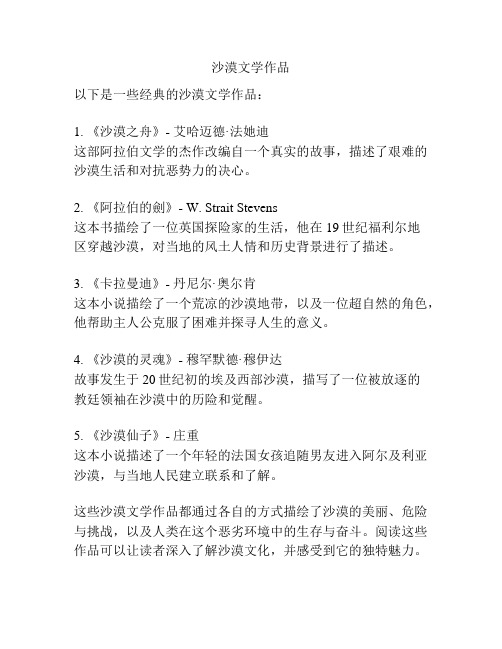
沙漠文学作品
以下是一些经典的沙漠文学作品:
1. 《沙漠之舟》- 艾哈迈德·法她迪
这部阿拉伯文学的杰作改编自一个真实的故事,描述了艰难的沙漠生活和对抗恶势力的决心。
2. 《阿拉伯的劍》- W. Strait Stevens
这本书描绘了一位英国探险家的生活,他在19世纪福利尔地
区穿越沙漠,对当地的风土人情和历史背景进行了描述。
3. 《卡拉曼迪》- 丹尼尔·奥尔肯
这本小说描绘了一个荒凉的沙漠地带,以及一位超自然的角色,他帮助主人公克服了困难并探寻人生的意义。
4. 《沙漠的灵魂》- 穆罕默德·穆伊达
故事发生于20世纪初的埃及西部沙漠,描写了一位被放逐的
教廷领袖在沙漠中的历险和觉醒。
5. 《沙漠仙子》- 庄重
这本小说描述了一个年轻的法国女孩追随男友进入阿尔及利亚沙漠,与当地人民建立联系和了解。
这些沙漠文学作品都通过各自的方式描绘了沙漠的美丽、危险与挑战,以及人类在这个恶劣环境中的生存与奋斗。
阅读这些作品可以让读者深入了解沙漠文化,并感受到它的独特魅力。
沙漠之舟课文原文

Ships in the DesertBy AL GoreI was standing in the sun on the hot steel deck of a fishing ship capable of processing a fifty-ton catch on a good day. But it wasn' t a good day. We were anchored in what used to be the most productive fishing site in all of central Asia, but as I looked out over the bow, the prospects of a good catch looked bleak. Where there should have been gentle blue-green waves lapping against the side of the ship, there was nothing but hot dry sand – as far as I could see in all directions. The other ships of the fleet were also at rest in the sand, scattered in the dunes that stretched all the way to the horizon. Ten year s ago the Aral was the fourth-largest inland sea in the world, comparable to the largest of North America's Great Lakes. Now it is disappearing because the water that used to feed it has been diverted in an ill-considered irrigation scheme to grow cotton In the user t. The new shoreline was almost forty kilometers across the sand from where the fishing fleet was now permanently docked. Meanwhile, in the nearby town of Muynak the people were still canning fish – brought not from the Aral Sea but shipped by rail through Siberia from the Pacific Ocean, more than a thousand miles away.My search for the underlying causes of the environmental crisis has led me to travel around the world to examine and study many of these images of destruction. At the very bottom of the earth, high in the Trans-Antarctic Mountains, with the sun glaring at midnight through a hole in the sky, I stood in the unbelievable coldness and talked with a scientist in the late tall of 1988 about the tunnel he was digging through time. Slipping his parka back to reveal a badly burned face that was cracked and peeling, he pointed to the annual layers of ice in a core sample dug from the glacier on which we were standing. He moved his finger back in time to the ice of two decades ago. "Here's where the U. S Congress passed the Clean Air Act,” he said. At the bottom of the world, two continents away from Washington, D. C., even a small reduction in one country's emissions had changed the amount of pollution found in the remotest end least accessible place on earth.But the most significant change thus far in the earth’s atmosphere is the one that began with the industrial r evolution early in the last century and has picked up speed ever since. Industry meant coal, and later oil, and we began to burn lots of it – bringing rising levels of carbon dioxide (CO2), with its ability to trap more heat in the atmosphere and slowly warm the earth. Fewer than a hundred yards from the South Pole, upwind from the ice runway where the ski plane lands and keeps its engines running to prevent the metal parts from freeze-locking together, scientists monitor the air sever al times ever y day to chart the course of that inexorable change. During my visit, I watched one scientist draw the results of that day's measurements, pushing the end of a steep line still higher on the graph. He told me how easy it is – there at the end of the earth – to see that this enormous change in the global atmosphere is still picking up speed.Two and a half years later I slept under the midnight sun at the other end of our planet, in a small tent pitched on a twelve-toot-thick slab of ice floating in the frigid Arctic Ocean. After a hearty breakfast, my companions and I traveled by snowmobiles a few miles farther north to a rendezvous point where the ice was thinner – only three and a half feet thick – and a nuclear submarine hovered in the water below. After it crashed through the ice, took on its new passengers, and resubmerged, I talked with scientists who were trying to measure more accurately the thickness of the polar ice cap, which many believe is thinning as a re-suit of global warming. I had just negotiated an agreement between ice scientists and the U. S. Navy to secure the re-lease of previously top secret data from submarine sonar tracks, data that could help them learn what is happening to the north polar cap. Now, I wanted to see the pole it-self, and some eight hours after we met the submarine, we were crashing through that ice, surfacing, and then I was standing in an eerily beautiful snowcape, windswept and sparkling white, with the horizon defined by little hummocks, or "pressure ridges " of ice that are pushed up like tiny mountain ranges when separate sheets collide. But here too, CD, levels are rising just as rapidly, and ultimately temperature will rise with them – indeed, global warming is expected to push temperatures up much more rapidly in the Polar Regions than in the rest of the world. As the polar air warms, the ice her e will thin; and since the polar cap plays such a crucial role in the world's weather system, the consequences of a thinning cap could be disastrous.Considering such scenarios is not a purely speculative exercise. Six months after I returned from the North Pole, a team of scientists reported dramatic changes in the pattern of ice distribution in the Arctic, and a second team reported a stillcontroversial claim (which a variety of data now suggest) that, over all, the north polar cap has thinned by 2 per cent in just the last decade. Moreover, scientists established several years ago that in many land areas north of the Arctic Circle, the spring snowmelt now comes earlier every year, and deep in the tundra below, the temperature e of the earth is steadily rising.As it happens, some of the most disturbing images of environmental destruction can be found exactly halfway between the North and South poles – precisely at the equator in Brazil – where billowing clouds of smoke regularly black-en the sky above the immense but now threatened Amazon rain forest. Acre by acre, the rain forest is being burned to create fast pasture for fast-food beef; as I learned when I went there in early 1989, the fires are set earlier and earlier in the dry season now, with more than one Tennessee's worth of rain forest being slashed and burned each year. According to our guide, the biologist Tom Lovejoy, there are more different species of birds in each square mile of the Amazon than exist in all of North America –which means we are silencing thousands of songs we have never even heard.But one doesn't have to travel around the world to witness humankind's assault on the earth. Images that signal the distress of our global environment are now commonly seen almost anywhere. On some nights, in high northern latitudes, the sky itself offers another ghostly image that signals the loss of ecological balance now in progress. If the sky is clear after sunset -- and it you are watching from a place where pollution hasn't blotted out the night sky altogether -- you can sometimes see a strange kind of cloud high in the sky. This "noctilucent cloud" occasionally appears when the earth is first cloaked in the evening darkness; shimmering above us with a translucent whiteness, these clouds seem quite unnatural. And they should: noctilucent clouds have begun to appear more often because of a huge buildup of methane gas in the atmosphere. (Also called natural gas, methane is released from landfills, from coal mines and rice paddies, from billions of termites that swarm through the freshly cut forestland, from the burning of biomass and from a variety of other human activities. ) Even though noctilucent clouds were sometimes seen in the past, all this extra methane carries more water vapor into the upper atmosphere, where it condenses at much higher altitudes to form more clouds that the sun's rays still strike long after sunset has brought the beginning of night to the surface far beneath them.What should we feel toward these ghosts in the sky? Simple wonder or the mix of emotions we feel at the zoo? Perhaps we should feel awe for our own power: just as men "ear tusks from elephants’ heads in such quantity as to threaten the beast with extinction, we are ripping matter from its place in the earth in such volume as to upset the balance between daylight and darkness. In the process, we are once again adding to the threat of global warming, be-cause methane has been one of the fastest-growing green-house gases, and is third only to carbon dioxide and water vapor in total volume, changing the chemistry of the upper atmosphere. But, without even considering that threat, shouldn't it startle us that we have now put these clouds in the evening sky which glisten with a spectral light? Or have our eyes adjusted so completely to the bright lights of civilization that we can't see these clouds for what they are –a physical manifestation of the violent collision between human civilization and the earth?Even though it is sometimes hard to see their meaning, we have by now all witnessed surprising experiences that signal the damage from our assault on the environment --whether it's the new frequency of days when the temperature exceeds 100 degrees, the new speed with which the -un burns our skin, or the new constancy of public debate over what to do with growing mountains of waste. But our response to these signals is puzzling. Why haven't we launched a massive effort to save our environment? To come at the question another way' Why do some images startle us into immediate action and focus our attention or ways to respond effectively? And why do other images, though sometimes equally dramatic, produce instead a Kin. of paralysis, focusing our attention not on ways to respond but rather on some convenient, less painful distraction?Still, there are so many distressing images of environ-mental destruction that sometimes it seems impossible to know how to absorb or comprehend them. Before considering the threats themselves, it may be helpful to classify them and thus begin to organize our thoughts and feelings so that we may be able to respond appropriately.A useful system comes from the military, which frequently places a conflict in one of three different categories, according to the theater in which it takes place. There are "local" skirmishes, "regional" battles, and "strategic" conflicts. This third category is reserved for struggles that can threaten a nation's survival and must be under stood in a global context.Environmental threats can be considered in the same way. For example, most instances of water pollution, air pollution, and illegal waste dumping are essentially local in nature. Problems like acid rain, the contamination of under-ground aquifers, and large oil spills are fundamentally regional. In both of these categories, there may be so many similar instances of particular local and regional problems occurring simultaneously all over the world that the patter n appears to be global, but the problems themselves are still not truly strategic because the operation of- the global environment is not affected and the survival of civilization is not at stake.However, a new class of environmental problems does affect the global ecological system, and these threats are fundamentally strategic. The 600 percent increase in the amount of chlorine in the atmosphere during the last forty years has taken place not just in those countries producing the chlorofluorocarbons responsible but in the air above every country, above Antarctica, above the North Pole and the Pacific Ocean – all the way from the surface of the earth to the top of the sky. The increased levels of chlorine disrupt the global process by which the earth regulates the amount of ultraviolet radiation from the sun that is allowed through the atmosphere to the surface; and it we let chlorine levels continue to increase, the radiation levels will al-so increase – to the point that all animal and plant life will face a new threat to their survival.Global warming is also a strategic threat. The concentration of carbon dioxide and other heat-absorbing molecules has increased by almost 25 per cent since World War II, posing a worldwide threat to the earth's ability to regulate the amount of heat from the sun retained in the atmosphere. This increase in heat seriously threatens the global climate equilibrium that determines the pattern of winds, rainfall, surface temperatures, ocean currents, and sea level. These in turn determine the distribution of vegetative and animal life on land and sea and have a great effect on the location and pattern of human societies.In other words, the entire relationship between humankind and the earth has been transformed because our civilization is suddenly capable of affecting the entire global environment, not just a particular area. All of us know that human civilization has usually had a large impact on the environment; to mention just one example, there is evidence that even in prehistoric times, vast areas were sometimes intentionally burned by people in their search for food. And in our own time we have reshaped a large part of the earth's surface with concrete in our cities and carefully tended rice paddies, pastures, wheat fields, and other croplands in the countryside. But these changes, while sometimes appearing to be pervasive, have, until recently, been relatively trivial factors in the global ecological sys-tem. Indeed, until our lifetime, it was always safe to assume that nothing we did or could do would have any lasting effect on the global environment. But it is precisely that assumption which must now be discarded so that we can think strategically about our new relationship to the environment.Human civilization is now the dominant cause of change in the global environment. Yet we resist this truth and find it hard to imagine that our effect on the earth must now be measured by the same yardstick used to calculate the strength of the moon's pull on the oceans or the force of the wind against the mountains. And it we are now capable of changing something so basic as the relationship between the earth and the sun, surely we must acknowledge a new responsibility to use that power wisely and with appropriate restraint. So far, however, We seem oblivious of the fragility of the earth's natural systems.This century has witnessed dramatic changes in two key factors that define the physical reality of our relation-ship to the earth: a sudden and startling surge in human population, with the addition of one China's worth of people every ten years, and a sudden acceleration of the scientific and technological revolution, which has allowed an almost unimaginable magnification of our power to affect the world around us by burning, cutting, digging, moving, and trans-forming the physical matter that makes up the earth. The surge in population is both a cause of the changed relationship and one of the clearest illustrations of how startling the change has been, especially when viewed in a historical context. From the emergence of modern humans 200 000 years ago until Julius Caesar's time, fewer than 250 million people walked on the face of the earth. When Christopher Columbus set sail for the New World 1500 years later, there were approximately 500 million people on earth. By the time Thomas Jefferson wrote the Declaration of Independence in 1776, the number had doubled again, to 1 billion. By midway through this century, at the end of World War II, the number had risen to just above 2 billion people. In other words, from the beginning of humanity's appearance on earth to 1945, it took more than ten thousand generations to reach a world populationof 2 billion people. Now, in the course of one human lifetime -- mine -- the world population will increase from 2 to more than 9 million, and it is already more than halfway there.Like the population explosion, the scientific and technological revolution began to pick up speed slowly during the eighteenth century. And this ongoing revolution has also suddenly accelerated exponentially. For example, it is now an axiom in many fields of science that more new and important discoveries have taken place in the last ten years that. in the entire previous history of science. While no single discover y has had the kind of effect on our relationship to the earth that unclear weapons have had on our relationship to warfare, it is nevertheless true that taken together, they have completely transformed our cumulative ability to exploit the earth for sustenance -- making the consequences, of unrestrained exploitation every bit as unthinkable as the consequences of unrestrained nuclear war.Now that our relationship to the earth has changed so utterly, we have to see that change and understand its implications. Our challenge is to recognize that the startling images of environmental destruction now occurring all over the world have much more in common than their ability to shock and awaken us. They are symptoms of an underlying problem broader in scope and more serious than any we have ever faced. Global warming, ozone depletion, the loss of living species, deforestation -- they all have a common cause: the new relationship between human civilization and the earth's natural balance. There are actually two aspects to this challenge. The first is to realize that our power to harm the earth can in-deed have global and even permanent effects. The second is to realize that the only way to understand our new role as a co-architect of nature is to see ourselves as part of a complex system that does not operate according to the same simple rules of cause and effect we are used to. The problem is not our effect on the environment so much as our relationship with the environment. As a result, any solution to the problem will require a careful assessment of that relationship as well as the complex interrelationship among factors within civilization and between them and the major natural components of the earth's ecological system.There is only one precedent for this kind of challenge to our thinking, and again it is military. The invention of nuclear weapons and the subsequent development by the Unit-ed States and the Soviet Union of many thousands of strategic nuclear weapons forced a slow and painful recognition that the new power thus acquired forever changed not only the relationship between the two superpowers but also the relationship of humankind to the institution at war-fare itself. The consequences of all-out war between nations armed with nuclear weapons suddenly included the possibility of the destruction of both nations –completely and simultaneously. That sobering realization led to a careful reassessment of every aspect of our mutual relationship to the prospect of such a war. As early as 1946 one strategist concluded that strategic bombing with missiles "may well tear away the veil of illusion that has so long obscured the reality of the change in warfare – from a fight to a process of destruction.”Nevertheless, during the earlier stages of the nuclear arms race, each of the superpower s assumed that its actions would have a simple and direct effect on the thinking of the other. For decades, each new advance in weaponry was deployed by one side for the purpose of inspiring fear in the other. But each such deployment led to an effort by the other to leapfrog the first one with a more advanced deployment of its own. Slowly, it has become apparent that the problem of the nuclear arms r ace is not primarily caused by technology. It is complicated by technology, true; but it arises out of the relationship between the superpowers and is based on an obsolete understanding of what war is all about.The eventual solution to the arms race will be found, not in a new deployment by one side or the other of some ultimate weapon or in a decision by either side to disarm unilaterally, but ratter in new understandings and in a mutual transformation of the relationship itself. This transformation will involve changes in the technology of weaponry and the denial of nuclear technology to rogue states. But the key changes will be in the way we think about the institution of war far e and about the relationship between states.The strategic nature of the threat now posed by human civilization to the global environment and the strategic nature of the threat to human civilization now posed by changes in the global environment present us with a similar set of challenges and false hopes. Some argue that a new ultimate technology, whether nuclear power or genetic engineering, will solve the problem. Others hold that only a drastic reduction of our reliance on technology can improve the conditions of life -- asimplistic notion at best. But the real solution will be found in reinventing and finally healing the relationship between civilization and the earth. This can only be accomplished by undertaking a careful reassessment of all the factors that led to the relatively recent dramatic change in the relationship. The transformation of the way we relate to the earth will of course involve new technologies, but the key changes will involve new ways of thinking about the relationship itself.NOTESI) Al Gore: born in 1948 in Washington D. C., U. S. Senator (1984-1992) from the State of Tennessee,and U. S. Vice-President ( l 992-) under President Bill Clinton. He is the author of the book Earth in the Balance from which this piece is taken.2) Aral Sea: inland sea and the world’s fourth largest lake, c. 26 000 sqmiles, SW Kazakhstan and NW Uzbekhst an, E of the Caspian Sea3) Great Lakes: group of five freshwater lakes, Central North America, between the United States and Canada, largest body of fresh water in the world. From west to east, they are Lake Superior,Lake Michigan,Lake Huron, Lake Erie, and Lake Ontario.4) Trans-Antarctic Mountains: mountain chain stretching across Antarctica from Victoria I and to Coats I and; separating theE Antarctic and W Antarctic subcontinents5) Clean Air Act: one of the oldest environmental laws of the U. S., as well as the most far-reaching, the costliest, and the most controversial. It was passed in 1970.6) Washington D. C.: capital of the United States. D. C. (District of Columbia).is added to distinguish it from the State of Washington and 3 other cities in the U. S bearing the sonic name.7) freeze-locking: the metal parts are frozen solid and unable to move freely8) midnight sun: phenomenon in which the sun remains visible in the sky for 24 hours or longer, occurring only in the polar regions9) global warming; The earth is getting warmer. The temperature of the earth's atmosphere and its surface is steadily rising.10) Submarine sonar tracks: the term sonar is an acronym for sound navigation ranging. It is used for communication between submerged submarines or between a submarine and a surface vessel, for locating mines and underwater hazards to navigation, and also as a fathometer, or depth finder.11) greenhouse (effect): process whereby heat is trapped at the surface of the earth by the atmosphere. An increase of man-made pollutants in the atmosphere will lead to a long-term warming of the earth's climate.12) Julius Caesar: (102? B. C -- 44 B. C:. ), Roman statesman and general13) Christopher Columbus: ( 1451-1506), discoverer of America, born Genoa, Italy14) Thomas Jefferson: (17-13-1826 ), 3d President of the United States(1801-1809), author of the Declaration of Independence.15) Declaration of Independence: full and formal declaration adopted July 4,1776, by representatives of the thirteen colonies in North America announcing the separation of those colonies from Great Britain and making them into the United States 16)Ozone depletion: A layer of ozone in the stratosphere prevents most ultraviolet and other high-energy radiation, which is harmful to life, from penetrating to the earth's surface.Some.environmental, scientists fear that certain man-made pollutants, e.g. nitric oxide, CFCs(Chlorofluorocarbons), etc., may interfere with the delicate balance of reactions that maintains the ozone’ s concentration, possibly leading to a drastic depletion of stratospheric ozone. This is now happening in the stratosphere above the polar regions.第三课沙漠之舟艾尔•戈尔我头顶烈日站在一艘渔船的滚烫的钢甲板上。
沙漠之舟课文主要内容
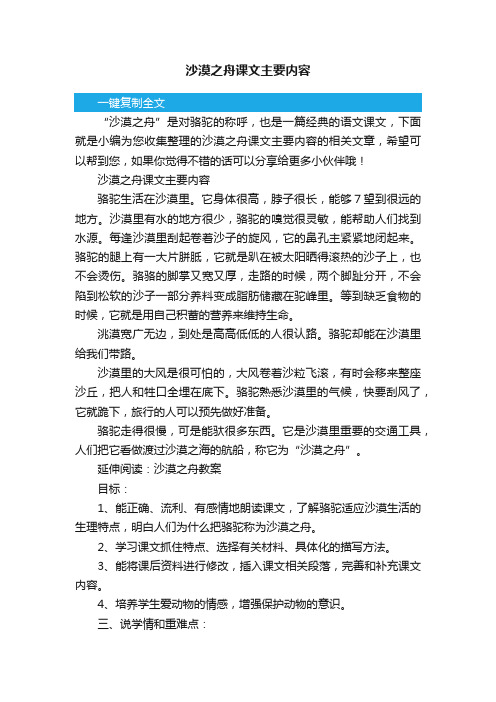
沙漠之舟课文主要内容“沙漠之舟”是对骆驼的称呼,也是一篇经典的语文课文,下面就是小编为您收集整理的沙漠之舟课文主要内容的相关文章,希望可以帮到您,如果你觉得不错的话可以分享给更多小伙伴哦!沙漠之舟课文主要内容骆驼生活在沙漠里。
它身体很高,脖子很长,能够7望到很远的地方。
沙漠里有水的地方很少,骆驼的嗅觉很灵敏,能帮助人们找到水源。
每逢沙漠里刮起卷着沙子的旋风,它的鼻孔主紧紧地闭起来。
骆驼的腿上有一大片胼胝,它就是趴在被太阳晒得滚热的沙子上,也不会烫伤。
骆骆的脚掌又宽又厚,走路的时候,两个脚趾分开,不会陷到松软的沙子一部分养料变成脂肪储藏在驼峰里。
等到缺乏食物的时候,它就是用自己积蓄的营养来维持生命。
洮漠宽广无边,到处是高高低低的人很认路。
骆驼却能在沙漠里给我们带路。
沙漠里的大风是很可怕的,大风卷着沙粒飞滚,有时会移来整座沙丘,把人和牲口全埋在底下。
骆驼熟悉沙漠里的气候,快要刮风了,它就跪下,旅行的人可以预先做好准备。
骆驼走得很慢,可是能驮很多东西。
它是沙漠里重要的交通工具,人们把它看做渡过沙漠之海的航船,称它为“沙漠之舟”。
延伸阅读:沙漠之舟教案目标:1、能正确、流利、有感情地朗读课文,了解骆驼适应沙漠生活的生理特点,明白人们为什么把骆驼称为沙漠之舟。
2、学习课文抓住特点、选择有关材料、具体化的描写方法。
3、能将课后资料进行修改,插入课文相关段落,完善和补充课文内容。
4、培养学生爱动物的情感,增强保护动物的意识。
三、说学情和重难点:根据教材编排的特点,我确定本文教学的重点为:学习课文抓住特点、选择有关材料、具体化的描写方法。
难点为:理解为什么把骆驼称为沙漠之舟。
四、说教法:本课教学采用问题探究的教法,引导学生带着问题,自己去读懂课文,获得知识。
凡是学生能读懂的,都让学生自己去读。
每一次读,教师都提出明确的要求,引导学生主动探索、理解。
着重对学生自主合作能力的培养。
同时,引导学生通过查阅资料,充分利用课外资源补充课内有限的内容,加深对课文内容的理解。
沙漠之舟的意思
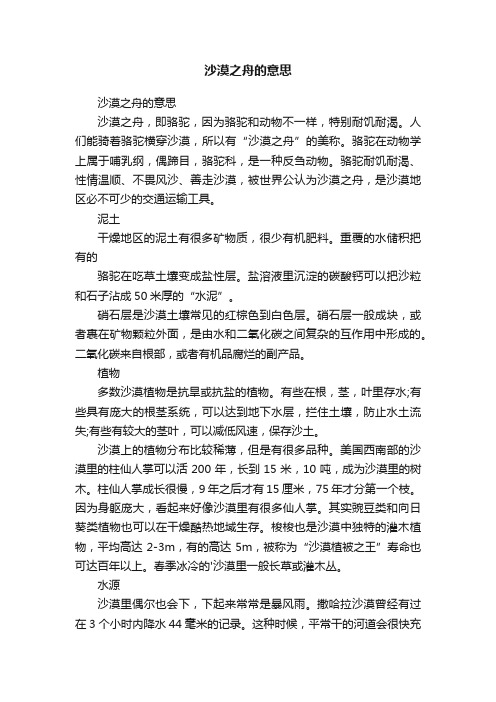
沙漠之舟的意思沙漠之舟的意思沙漠之舟,即骆驼,因为骆驼和动物不一样,特别耐饥耐渴。
人们能骑着骆驼横穿沙漠,所以有“沙漠之舟”的美称。
骆驼在动物学上属于哺乳纲,偶蹄目,骆驼科,是一种反刍动物。
骆驼耐饥耐渴、性情温顺、不畏风沙、善走沙漠,被世界公认为沙漠之舟,是沙漠地区必不可少的交通运输工具。
泥土干燥地区的泥土有很多矿物质,很少有机肥料。
重覆的水储积把有的骆驼在吃草土壤变成盐性层。
盐溶液里沉淀的碳酸钙可以把沙粒和石子沾成50米厚的“水泥”。
硝石层是沙漠土壤常见的红棕色到白色层。
硝石层一般成块,或者裹在矿物颗粒外面,是由水和二氧化碳之间复杂的互作用中形成的。
二氧化碳来自根部,或者有机品腐烂的副产品。
植物多数沙漠植物是抗旱或抗盐的植物。
有些在根,茎,叶里存水;有些具有庞大的根茎系统,可以达到地下水层,拦住土壤,防止水土流失;有些有较大的茎叶,可以减低风速,保存沙土。
沙漠上的植物分布比较稀薄,但是有很多品种。
美国西南部的沙漠里的柱仙人掌可以活200年,长到15米,10吨,成为沙漠里的树木。
柱仙人掌成长很慢,9年之后才有15厘米,75年才分第一个枝。
因为身躯庞大,看起来好像沙漠里有很多仙人掌。
其实豌豆类和向日葵类植物也可以在干燥酷热地域生存。
梭梭也是沙漠中独特的灌木植物,平均高达2-3m,有的高达5m,被称为“沙漠植被之王”寿命也可达百年以上。
春季冰冷的'沙漠里一般长草或灌木丛。
水源沙漠里偶尔也会下,下起来常常是暴风雨。
撒哈拉沙漠曾经有过在3个小时内降水44毫米的记录。
这种时候,平常干的河道会很快充满水,容易发洪水。
虽然沙漠内部少下雨,沙漠常从附近高山流出的河流进水。
这些河流一般带着很多土,在沙漠里流了一两天的距离就干了。
世界上只有几条大河流通沙漠,如埃及的尼罗河,中国的黄河,和美国的科罗拉多河。
如果水足够,沙漠里会形成季节湖,一般较浅较咸。
因为湖底很平,风会把湖吹到好几十平方公里。
小湖干了之后会留下一个盐滩。
沙漠之舟故事
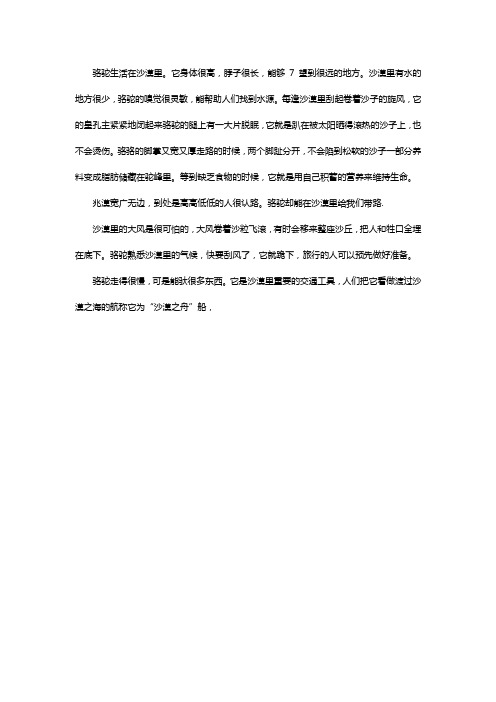
骆驼生活在沙漠里。
它身体很高,脖子很长,能够7望到很远的地方。
沙漠里有水的地方很少,骆驼的嗅觉很灵敏,能帮助人们找到水源。
每逢沙漠里刮起卷着沙子的旋风,它的皇孔主紧紧地闭起来骆驼的腿上有一大片脱眠,它就是趴在被太阳晒得滚热的沙子上,也不会烫伤。
骆骆的脚掌又宽又厚走路的时候,两个脚趾分开,不会陷到松软的沙子一部分养料变成脂肪储藏在驼峰里。
等到缺乏食物的时候,它就是用自己积蓄的营养来维持生命。
兆漠宽广无边,到处是高高低低的人很认路。
骆驼却能在沙漠里给我们带路.
沙漠里的大风是很可怕的,大风卷着沙粒飞滚,有时会移来整座沙丘,把人和牲口全埋在底下。
骆驼熟悉沙漠里的气候,快要刮风了,它就跪下,旅行的人可以预先做好准备。
骆驼走得很慢,可是能驮很多东西。
它是沙漠里重要的交通工具,人们把它看做渡过沙漠之海的航称它为“沙漠之舟”船,。
- 1、下载文档前请自行甄别文档内容的完整性,平台不提供额外的编辑、内容补充、找答案等附加服务。
- 2、"仅部分预览"的文档,不可在线预览部分如存在完整性等问题,可反馈申请退款(可完整预览的文档不适用该条件!)。
- 3、如文档侵犯您的权益,请联系客服反馈,我们会尽快为您处理(人工客服工作时间:9:00-18:30)。
外形特点和种类
骆驼头较小,颈粗而长,弯曲如鹅颈。躯体高大, 体毛褐色。眼为重睑,鼻孔能开闭,四肢细长, 蹄大如盘,两趾有厚皮,都是适于沙地行走的特 征。尾细长,尾端有丛毛。背有1~2 个较大驼峰, 内贮脂肪。性情温顺,常单独活动,食粗草及灌 木。寿命约30年。 骆驼有两种,有一个驼峰的单峰骆驼和两个驼峰 的双峰骆驼。单峰骆驼比较高大,在沙漠中能走 能跑,可以运货,也能驮人。双峰骆驼四肢粗短, 更适合在沙砾和雪地上行走。
自己动手表现 你心中的骆驼
猜一猜:
四腿长长脖子弯, 背上驮着两座山, 一次吃饱水和草, 几天不饿口不干, 驮着重担走沙漠, 不怕烈日和风寒。
思考讨论:
1.骆驼有哪些生活习性? 2.骆驼的外形有什么特点? 3.朋友?不 会讲话的骆驼朋友“告诉”了我们 什么?
骆驼这种动物,对人非常忠诚,它和其 它动物不一样,特别耐饥耐渴,人们能骑着 骆驼横穿沙漠。骆驼还有着“沙漠之舟”的 美称。骆驼的驼峰里贮存着脂肪,这些脂肪 在骆驼得不到食物的时候,能够分解成骆驼 身体所需要的养分,供骆驼生存需要。骆驼 能够连续四五天不进食,就是靠驼峰里的脂 肪。另外,骆驼的胃里有许多瓶子形状的小 泡泡,那是骆驼贮存水的地方,这些“瓶子” 里的水使骆驼即使几天不喝水,也不会有生 命危险。
